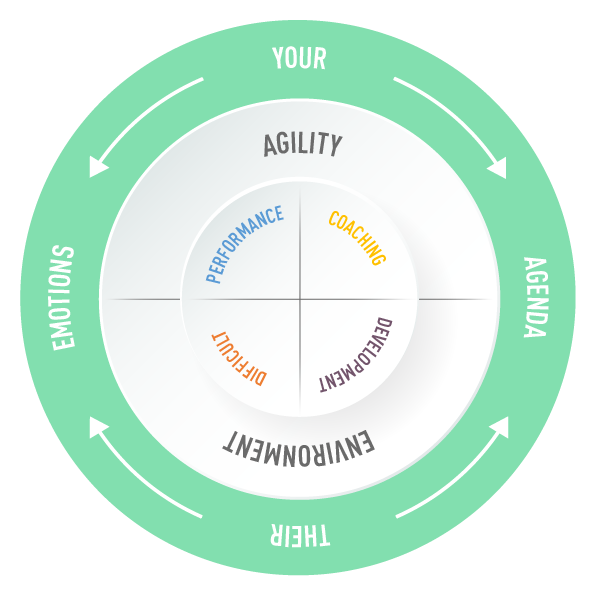Conversations in a Virtual World – 5 Steps for Success
We are in challenging times, and they're challenging, not just because we're in a pandemic, in isolation, locked down... but also because from a conversation perspective, we're always taught that face to face conversations are best and most of us can’t see anybody face to face!
Conversations are the glue that hold businesses, teams and people together and now we all need to hold effective, successful conversations virtually. This may take a shift in mindset and skills to ensure we get the most positive outcomes and results.
The Ascend Successful Conversations model (see below) is the basis for the work we do to support and challenge leaders at all levels to have more successful conversations in the distributed and remote working environment we find ourselves in.
1. What is your agenda?
It is important to give proper pre-thought and planning to what is your agenda for having the conversation. Why are you having it? What do you want to get out of the conversation? What would a good outcome for you be like?
Try to understand what the other person might want from the conversations. What are their expectations? What would they want to walk away with and what could ‘win-win’ look like?
2. Have you thought about your emotions?
Another key thing to think about is your emotional state when having the conversation. Do you want to be calm and considered, or would warmth and passion be more appropriate in conveying the messages you are trying to get across?
Additionally, think about how the other person might react – especially if it is a challenging conversation. How do you deliver your message to get the intended emotional response? How will you respond if they react in a certain (e.g. negative) way?
3. Consider the environment you will be in.
In face to face conversations we are able to use the full bandwidth of words, tone, and body language, which all give us vital clues on how a message is being received and where there might be potential for misunderstanding – this is why email can be a terrible conversational tool! Ideally, therefore we would hold all our virtual conversations with cameras on. It is important to think about what channel/technology/medium would give the best option to have a successful conversation.
4. Be agile. Yes, it has a place in conversations too.
Successful conversations are usually an agile blend of receive and transmit from both parties. Are you getting the balance right? Are you employing effective questioning and listening skills to really understand the other person’s situation/point of view? Are you being clear and concise in the messages that you want to get across? Are you demonstrating agility and judgment in the way you transition from listening to speaking and back and forth?
5. Understand what type of conversation you are having
In our experience, most conversations at work, especially those between leaders and their people fall into the following four buckets:
Performance conversations
Here, we are not talking about formal reviews but the giving of positive and development feedback to let people know how they are doing against performance and behavioural goals on an informal regular basis. Our Successful Conversations in a Virtual World workshop provides some golden rules around how you might do that successfully when not able to do so face to face.
Coaching conversations
In the early stages of the pandemic, many companies and leaders reverted to ‘command and control’ techniques to mobilise their people. However, some have found it more effective to stretch people out of their comfort zones and help them to reach their potential by giving more autonomy via coaching conversations. Previously, these were often one to one conversations that you would normally have face to face, so how do you have a good coaching conversation online or by phone? What sort of questioning or listening (and observational) techniques can you use to maximise the quality of these conversations?
Development conversations
There are two types of development conversations. Firstly, there are short-term focused ones that target improvement in role (and may be covered in the performance conversation above). These specifically address what the person needs to do differently to improve - and how they might get there.
The second type of development conversation relates to the longer-term focus of development related to supporting an individual to have a fulfilling career that matches their aspirations.
Ascend has insight and frameworks to help people have worthwhile conversations in both these areas of development, many of which are covered in the Successful Conversations in a Virtual World programme.
Difficult conversations
Sometimes the conversations we’ve listed above can be difficult ones. And, at the current time with some businesses having to furlough staff, ask people to take on different roles/challenges and/or pay cuts, there are many other examples of potentially difficult conversations. These difficult conversations are the ones that need the most practice, rehearsal and feedback.
We have a specific framework to help people structure these conversations and practice landing them in the most effective and empathetic way.
Our Successful Remote Conversations Virtual Programme provides participants with a toolkit and action focus to have successful conversations with their people in a world where sitting down face to face is a choice we may no longer have. It enables us to quality conversations with all our people no matter where they may be based in the world.
Run over two 75 minute sessions, it is a high-impact and cost-effective virtual leadership development programme designed to help leaders communicate in our new remote world of work.
Download the brochure to find out more, or CONTACT US.



![4[3].png](https://images.squarespace-cdn.com/content/v1/5b0567935b409beb7a944b4c/1591204524096-PHJQDBR1MONTVROUCPTO/4%5B3%5D.png)